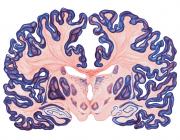The neural basis of biased competition in human visual cortex.
Publication Year
2001
Type
Journal Article
Abstract
A typical scene contains many different objects that compete for neural representation due to the limited processing capacity of the visual system. At the neural level, competition among multiple stimuli is evidenced by the mutual suppression of their visually evoked responses and occurs most strongly at the level of the receptive field. The competition among multiple objects can be biased by both bottom-up sensory-driven mechanisms and top-down influences, such as selective attention. Functional brain imaging studies reveal that biasing signals due to selective attention can modulate neural activity in visual cortex not only in the presence, but also in the absence of visual stimulation. Although the competition among stimuli for representation is ultimately resolved within visual cortex, the source of top-down biasing signals likely derives from a distributed network of areas in frontal and parietal cortex. Attention-related activity in frontal and parietal areas does not reflect attentional modulation of visually evoked responses, but rather the attentional operations themselves.
Keywords
Journal
Neuropsychologia
Volume
39
Pages
1263-76
ISSN Number
0028-3932
Alternate Journal
Neuropsychologia
PMID
11566310

